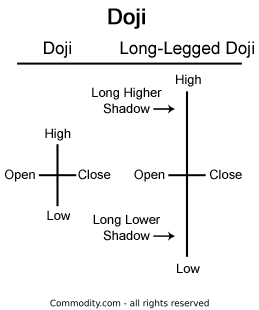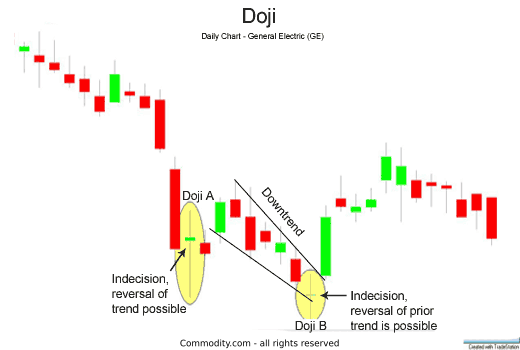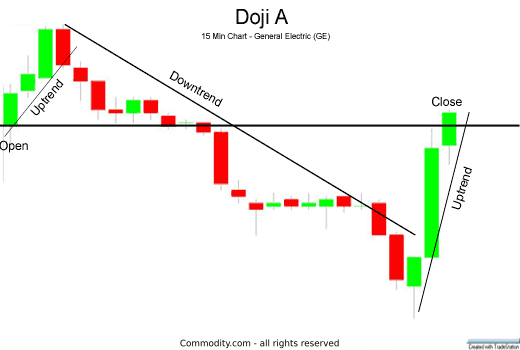In this guide to understanding doji candlestick technical indicators, we’ll show you what this chart looks like, explain its components, teach you how to interpret it with examples, and discuss its variations. We also explain the intra-day doji.
Contents
What Is a Doji Candlestick Pattern?
The doji is a transitional candlestick formation, signifying equality or indecision between bulls and bears.
A doji is quite often found at the bottom and top of trends and thus is considered as a sign of possible reversal of price direction, but the doji can be viewed as a continuation pattern as well.
How Do You Read a Doji Candlestick?
A doji is formed when the opening price and the closing price are equal. A long-legged doji, often called a “Rickshaw Man,” is the same as a doji, except the upper and lower shadows are much longer than the regular doji formation.

The creation of the doji pattern illustrates why the doji represents such indecision. After the open, bulls push prices higher only for prices to be rejected and pushed lower by the bears. However, bears are unable to keep prices lower, and bulls then push prices back to the opening price.
A doji could be formed by prices moving lower first and then higher second. Either way, the market closes back where the day started.
Doji Examples
Chart 1 below of General Electric (GE) shows two examples of doji patterns:

Doji After an Uptrend or Downtrend
In a doji pattern, the market explores its options both upward and downward, but cannot commit either way. After a long uptrend, this indecision manifest by the doji could be viewed as a time to exit one’s position, or at least scale back.
After a long downtrend, like the one shown in Chart 1 above of General Electric stock, reducing one’s position size or exiting completely could be an intelligent move.
Doji Means Indecision
It is important to emphasize that the doji pattern does not mean reversal, it means indecision. doji are often found during periods of resting after a significant move higher or lower. The market, after resting, then continues on its way.
Nevertheless, a doji pattern could be interpreted as a sign that a prior trend is losing its strength, and taking some profits might be well advised.
Intra-day Doji Formations
The first doji outlined on Chart 1 in the previous section was a high-low doji, where prices made the highs for the day first, and the lows for the day second.
Doji After a Downtrend
The intra-day chart (15-minute) of this occurrence is given in Chart 2 below:

In Chart 2 above (doji A), at the opening, the bulls were in charge. However, the morning rally did not last long before the bears took over. From mid-morning until late-afternoon, General Electric sold off, but by the end of the day, bulls pushed GE back to the opening price of the day.
Doji After an Uptrend

In Chart 3 above (doji B), the doji moved in the opposite direction from the movement shown in Chart 2. That is, Doji B made its day’s lows first, then highs second.
Summary of Doji Examples
At the opening bell, bears took a hold of GE, but by mid-morning, bulls entered into GE’s stock, pushing GE into positive territory for the day. Unfortunately for the bulls, by noon bears took over and pushed GE lower.
By the end of the day, the bears had successfully brought the price of GE back to the day’s opening price.
The doji formation can be created two different ways, but the interpretation of the doji remains the same: the doji pattern is a sign of indecision, neither bulls nor bears can successfully take over.
Other Doji Variations
There are two important variations of the doji formation:
- Dragonfly Doji – A bullish reversal pattern that occurs at the bottom of downtrends.
- Gravestone Doji – A bearish reversal occurring at the top of uptrends.
Where Can I Trade?
Start your research with reviews of these regulated brokers available in , many have free demo accounts so you can preview their technical analysis features.
CFDs are complex instruments and come with a high risk of losing money rapidly due to leverage. Between 74%-89% of retail investor accounts lose money when trading CFDs. You should consider whether you can afford to take the high risk of losing your money.
FAQs
Here are some answers to common questions about doji candlesticks.
Is a doji bullish or bearish?
A doji is neither bearish nor bullish, but instead indicates that the market is evenly divided or indecisive. It can happen after a bullish run, indicating the bears are fighting back — or vice versa. More definitive doji patterns are called Gravestone doji (bearish reversal) or a Dragonfly doji (bullish reversal)
What happens after a doji candle?
On its own, a doji isn’t a reliable predictor of what may happen to the market next. Rather, a doji formation indicates that the market is undecided. Traders may find momentum indicators or stochastic indicators can help them understand what may happen after a doji formation.
Is Doji a reversal pattern?
Although a doji can indicate that a reversal of price direction is in progress, it can also be a continuation pattern where prices hover at their current value. The Gravestone doji and the Dragonfly doji are stronger indicators of price reversal than a standard doji.
Further Reading
Learn more about technical analysis indicators, concepts, and strategies including:


